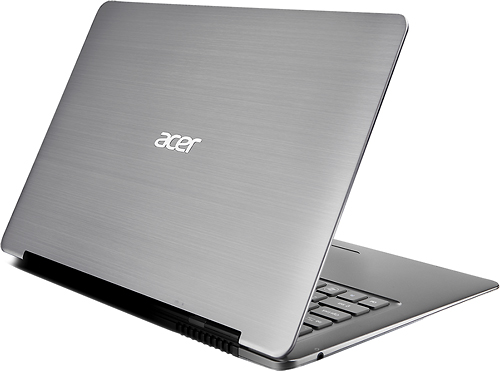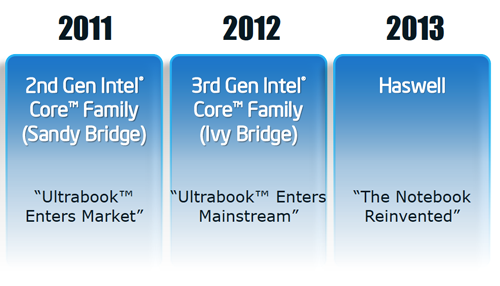Second-Generation Ultrabooks: Faster And Cheaper With Ivy Bridge
Intel: On Top In This Space, For Now
Although Ivy Bridge is a "tick" in Intel's tick-tock manufacturing cadence, the company calls it a "tick-plus" due to the extreme changes that found their way into its HD Graphics 4000 engine, affecting the outcome of today's story more than we might have expected from a mere "tick" in the past. The performance of Core i5-3427U's x86 cores receive a small boost, sure, but it's really the integrated graphics engine that shines most brightly, particularly in the strict bounds of a 17 W thermal ceiling. The effectiveness of fixed-function logic means that Intel's Quick Sync feature is just as effective as what you'll find on the desktop, and HD Graphics 4000 makes it possible to see playable frame rates in mainstream titles like World of Warcraft.
Naturally, if you're in the market for a compact notebook, an Ivy Bridge-based Ultrabook has to be on your short list. An Apple MacBook Air with a third-gen Core i5 and 13-inch screen starts at $1200. Its 1440x900 panel boasts a higher resolution than some Ultrabooks, and a lower resolution than others. But we've seen some particularly impressively-equipped Ultrabooks with better specs at lower prices than Apple's best effort. We're not certain if Intel is right in its postulation that this year's Ultrabooks will go mainstream, but smart buyers will almost assuredly find cheaper solutions on the PC side.
Much of the Ultrabook initiative's success will, not surprisingly, come down to what Intel charges for its processors. The Core i5-2467M in our Acer S3-951 Ultrabook is listed at $250. Today, you can get that same CPU with a 240 GB SSD and a 13.3" LCD under the same Acer model name for less than $800. That's pretty compelling.
Now, consider that the Core i5-3427U is listed for $225, cheaper than the -2467M. More performance and a lower price? Hopefully, this is evidence that Intel is trying to push the barrier to entry for its Ultrabooks lower than the prior generation.
I think it's clear that the real sweet spot for an Ultrabook, particularly given pressure from notably less expensive tablets, is under $1000. Maybe it's more like $700 or $800 where road warriors think to themselves that it's worth spending an extra few hundred dollars to get performance more similar to the desktop PC they use at home rather than the smartphone in their pocket.
It's almost too easy to forget that Intel wins in any case. Buy Apple. Buy HP. Buy Dell. Buy Samsung. They all have Intel CPUs in them. According to the company's roadmap, Haswell will be the architecture that goes beyond mainstream to make Ultrabook the de facto definition of what it means to buy a notebook.
Of course, that's if AMD has nothing to say about Intel's blitzkrieg. Although the company has no Ultrabook-like challenger, its Trinity-based APUs debuted a couple of months back, and we've already seen evidence of a 17 W incarnation. We've seen higher-wattage mobile and desktop chips based on the Trinity design that obliterate Intel's graphics performance. Can the company scale down in the CULV space to do the same thing? All eyes are on AMD for some indication of when we might see retail configurations sporting its Piledriver/VLIW4-based single-chip solution.
Get Tom's Hardware's best news and in-depth reviews, straight to your inbox.
Until then, Intel enjoys uncontested dominance in the space that its Ultrabooks target. Sure, it still has to stave off tablets underneath and more potent notebooks above. But as the Ivy Bridge architecture reaches across a broader market than Sandy Bridge, we expect Ultrabooks to put more pressure on both bounds of its $800-$1200 price band.
Current page: Intel: On Top In This Space, For Now
Prev Page Benchmark Results: Blu-ray Playback Efficiency-
sam_fisher It seems that Ivy Bridge's lower TDP and its HD 4000 comes into its own in the notebook/ultrabook market more so than the PC/gaming one.Reply -
sam_fisher crisan_tiberiuthey should use HD 4000 on every intel CPU, i dont get it why they dont ...Reply
The integrated graphics is built into the processor die and the changes between the HD 3000 and 4000 are physical changes, so they can't just change them without changing the whole CPU.
-
mayankleoboy1 crisan_tiberiuthey should use HD 4000 on every intel CPU, i dont get it why they dont ...Reply
Pricing, TDP, segmentation and PROFIT -
crisan_tiberiu sam_fisherThe integrated graphics is built into the processor die and the changes between the HD 3000 and 4000 are physical changes, so they can't just change them without changing the whole CPU. Yes, i know that :)) but when they designed IVY they should have designed every chip with the HD 4000. The HD 4000 is still outperformed by Liano iGPU if you remember...Reply -
tomfreak Cant u put an older/previous generation desktop and benchmark against it? I cant or couldnt get how a fast a 2.0GHz Ivy vs a similar Nehelem Desktop CPU vs desktop core 2 duo CPU. Many of us buy notebook to replace desktop for casual use, we would like to know what it can do vs our old desktop.Reply
Besides get some older AAA games to bench, nobody play BF3 at Ultra books with HD4000. We wanna see what old games we can max out @ full resolution. -
silverblue I think AMD missed a trick with Llano. Instead of throwing four lowly clocked cores at a mobile processor, perhaps two higher clocked cores would've made much more sense. That way, they could possibly sport a higher clock GPU as well within the same TDP.Reply
Trinity's lower powered, higher clocked cores already look to have partly made up for this, but until the 17W variant comes along, there's no real indication of how it'll measure up to IB ULV. However, we do know that AMD pairs the slower GPUs with the slower CPUs and vice versa, so there's little chance of a, say, 2C/2T/1M CPU with the 7660G GPU. -
DjEaZy ... ok... you compare the Llano to Sandy/Ivy bridge in CPU performance, but not in GPU performance? and why not Sandy/Ivy Bridge to Trinity?Reply
... and Adobe Photoshop CS 5? not CS 6?

